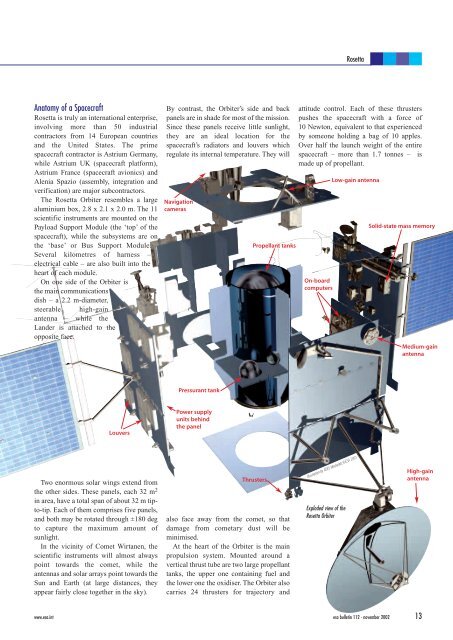Why 'Rosetta'? - ESA
Why 'Rosetta'? - ESA
Why 'Rosetta'? - ESA
Create successful ePaper yourself
Turn your PDF publications into a flip-book with our unique Google optimized e-Paper software.
Anatomy of a Spacecraft<br />
Rosetta is truly an international enterprise,<br />
involving more than 50 industrial<br />
contractors from 14 European countries<br />
and the United States. The prime<br />
spacecraft contractor is Astrium Germany,<br />
while Astrium UK (spacecraft platform),<br />
Astrium France (spacecraft avionics) and<br />
Alenia Spazio (assembly, integration and<br />
verification) are major subcontractors.<br />
The Rosetta Orbiter resembles a large<br />
aluminium box, 2.8 x 2.1 x 2.0 m. The 11<br />
scientific instruments are mounted on the<br />
Payload Support Module (the ‘top’ of the<br />
spacecraft), while the subsystems are on<br />
the ‘base’ or Bus Support Module.<br />
Several kilometres of harness –<br />
electrical cable – are also built into the<br />
heart of each module.<br />
On one side of the Orbiter is<br />
the main communications<br />
dish – a 2.2 m-diameter,<br />
steerable high-gain<br />
antenna – while the<br />
Lander is attached to the<br />
opposite face.<br />
Louvers<br />
Two enormous solar wings extend from<br />
the other sides. These panels, each 32 m 2<br />
in area, have a total span of about 32 m tipto-tip.<br />
Each of them comprises five panels,<br />
and both may be rotated through ±180 deg<br />
to capture the maximum amount of<br />
sunlight.<br />
In the vicinity of Comet Wirtanen, the<br />
scientific instruments will almost always<br />
point towards the comet, while the<br />
antennas and solar arrays point towards the<br />
Sun and Earth (at large distances, they<br />
appear fairly close together in the sky).<br />
By contrast, the Orbiter’s side and back<br />
panels are in shade for most of the mission.<br />
Since these panels receive little sunlight,<br />
they are an ideal location for the<br />
spacecraft’s radiators and louvers which<br />
regulate its internal temperature. They will<br />
Navigation<br />
cameras<br />
Pressurant tank<br />
Power supply<br />
units behind<br />
the panel<br />
Propellant tanks<br />
Thrusters<br />
also face away from the comet, so that<br />
damage from cometary dust will be<br />
minimised.<br />
At the heart of the Orbiter is the main<br />
propulsion system. Mounted around a<br />
vertical thrust tube are two large propellant<br />
tanks, the upper one containing fuel and<br />
the lower one the oxidiser. The Orbiter also<br />
carries 24 thrusters for trajectory and<br />
On-board<br />
computers<br />
Rosetta<br />
attitude control. Each of these thrusters<br />
pushes the spacecraft with a force of<br />
10 Newton, equivalent to that experienced<br />
by someone holding a bag of 10 apples.<br />
Over half the launch weight of the entire<br />
spacecraft – more than 1.7 tonnes – is<br />
made up of propellant.<br />
Low-gain antenna<br />
Illustration by AOES Medialab, ©<strong>ESA</strong> 2001<br />
Exploded view of the<br />
Rosetta Orbiter<br />
Solid-state mass memory<br />
Medium-gain<br />
antenna<br />
www.esa.int esa bulletin 112 - november 2002 13<br />
High-gain<br />
antenna
















